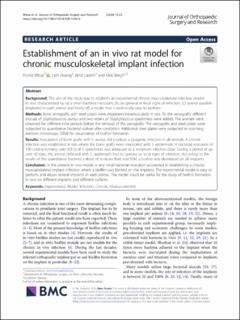| dc.contributor.author | Witsø, Eivind | |
| dc.contributor.author | Hoang, Linh | |
| dc.contributor.author | Løseth, Kirsti | |
| dc.contributor.author | Bergh, Kåre | |
| dc.date.accessioned | 2022-05-04T09:22:39Z | |
| dc.date.available | 2022-05-04T09:22:39Z | |
| dc.date.created | 2020-10-29T15:20:19Z | |
| dc.date.issued | 2020 | |
| dc.identifier.citation | Journal of Orthopaedic Surgery and Research. 2020, 15 (1), 1-8. | en_US |
| dc.identifier.issn | 1749-799X | |
| dc.identifier.uri | https://hdl.handle.net/11250/2994086 | |
| dc.description.abstract | Background
The aim of the study was to establish an experimental chronic musculoskeletal infection model in vivo characterized by (a) a small bacterial inoculum, (b) no general or local signs of infection, (c) several parallels (implants) in each animal and finally (d) a model that is technically easy to perform.
Methods
Bone xenografts with steel plates were implanted intramuscularly in rats. To the xenografts, different inocula of Staphylococcus aureus and two strains of Staphylococcus epidermidis were added. The animals were observed for different time periods before the removal of the xenografts. The xenografts and steel plates were subjected to quantitative bacterial culture after sonication. Additional steel plates were subjected to scanning electron microscopy (SEM) for visualization of biofilm formation.
Results
Inoculation of bone grafts with S. aureus did produce a pyogenic infection in all animals. A chronic infection was established in rats where the bone grafts were inoculated with S. epidermidis. A bacterial inoculum of 100 colony-forming units (CFU) of S. epidermidis was adequate as a minimum infective dose. During a period of up until 42 days, the animals infected with S. epidermidis had no general or local signs of infection. According to the results of the quantitative bacterial culture of sonicate fluid and SEM, a biofilm was developed on all implants.
Conclusion
In the present in vivo model, a very small bacterial inoculum succeeded in establishing a chronic musculoskeletal implant infection where a biofilm was formed on the implants. The experimental model is easy to perform and allows several implants in each animal. The model could be useful for the study of biofilm formation in vivo on different implants and different surfaces. | en_US |
| dc.language.iso | eng | en_US |
| dc.publisher | BMC | en_US |
| dc.rights | Navngivelse 4.0 Internasjonal | * |
| dc.rights.uri | http://creativecommons.org/licenses/by/4.0/deed.no | * |
| dc.title | Establishment of an in vivo rat model for chronic musculoskeletal implant infection | en_US |
| dc.title.alternative | Establishment of an in vivo rat model for chronic musculoskeletal implant infection | en_US |
| dc.type | Peer reviewed | en_US |
| dc.type | Journal article | en_US |
| dc.description.version | publishedVersion | en_US |
| dc.source.pagenumber | 1-8 | en_US |
| dc.source.volume | 15 | en_US |
| dc.source.journal | Journal of Orthopaedic Surgery and Research | en_US |
| dc.source.issue | 1 | en_US |
| dc.identifier.doi | 10.1186/s13018-020-1546-6 | |
| dc.identifier.cristin | 1843327 | |
| cristin.ispublished | true | |
| cristin.fulltext | original | |
| cristin.qualitycode | 1 | |

